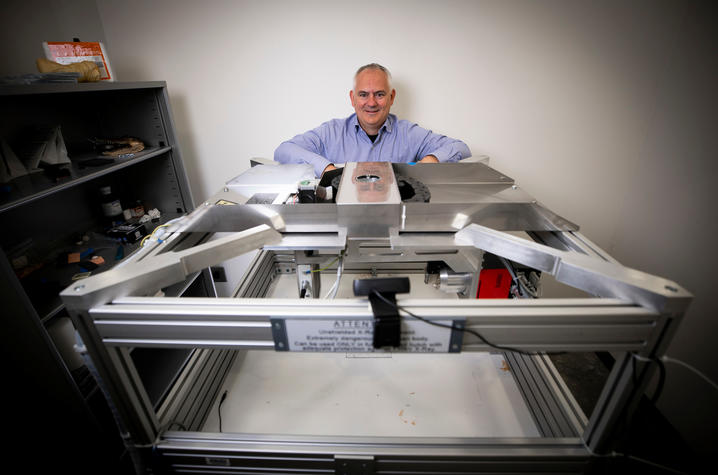NEH to Help UK Build One-of-a-Kind Lab for Imaging, Restoring Ancient Artifacts

The University of Kentucky is one step closer to becoming a global center for imaging and restoring ancient artifacts thought to be damaged beyond repair.
Brent Seales, professor and chair of the Department of Computer Science, is the recipient of a National Endowment for the Humanities (NEH) grant to create EduceLab — a cultural heritage imaging and analysis laboratory.
Seales is among 213 recipients of NEH grants, totaling $32.8 million, awarded to humanities projects across the country.
“As we conclude an extremely difficult year for our nation and its cultural institutions, it is heartening to see so many excellent projects being undertaken by humanities scholars, researchers, curators and educators,” Jon Parrish Peede, NEH chairman, said. “These new NEH grants will foster intellectual inquiry, promote broad engagement with history, literature and other humanities fields, and expand access to cultural collections and resources for all Americans.”
The $500,000 challenge grant, which depends on matching donations to unlock the funding, will help Seales develop and construct a world-class digital imaging and restoration lab on UK’s campus.
A joint endeavor of the College of Arts and Sciences and the College of Engineering, the facility will focus on developing innovative artificial intelligence (AI) solutions to the unique challenges presented by cultural heritage objects.
“Outfitted with state-of-the-art equipment designed to protect damaged artifacts, the EduceLab will allow for extensive imaging of 3D objects far beyond what is currently possible,” Seales said. “Additionally, the lab will serve as a home for new AI tools we can use to restore even the most hopeless cases, such as the Herculaneum scrolls.”
These papyri — which have served as the impetus for much of Seales’ research — are among the most iconic, and inaccessible, of the world’s vast collection of damaged manuscripts. Buried and burned in the eruption of Mount Vesuvius in 79 C.E. (A.D), the scrolls offer a unique window to the ancient world — but they are too fragile to unroll. Additionally, they were penned using carbon ink, which proves extremely difficult to reveal using X-ray technology.
You might remember, Seales developed the "Volume Cartographer," a revolutionary computer program for locating and mapping 2D surfaces within a 3D object. This software pipeline is used to generate extremely high-resolution images of otherwise unviewable text — enabling the ability to read a document without ever needing to physically open it. A breakthrough not only in digital imaging techniques, the first-of-its-kind software has profoundly impacted history and literature.
Using the tool to reveal sealed secrets has become Seales' area of expertise. In 2016, his team virtually unwrapped the scroll from En Gedi — representing the first time writing was revealed from within an unopened object.
"I have not seen many cases where either artificial intelligence or machine learning (ML) has been applied within heritage science in a convincing and meaningful way," Thomas Learner, head of science at the Getty Conservation Institute where Seales spent his 2019-20 sabbatical, said. "That all changed when I saw Professor Seales' examples of using ML to read unreadable texts in unwrapped scrolls. I believe his team is capable of making this technology available to a far wider section of the field."
But each artifact is unique, and some pose more significant challenges.
The team is currently developing machine learning approaches to reveal the carbon ink used in the Herculaneum scrolls. Unfortunately, no facility currently exists for investigating these new technical approaches.
EduceLab will fill this crucial gap in the heritage restoration field.
"Professor Seales' project promises a world-class digital imaging and restoration lab with the potential to encourage and support interdisciplinary research and writing at the University of Kentucky," Jeffrey Rice, chair of the Department of Writing, Rhetoric, and Digital Studies, said. "Research, potential jobs for students and learning in general are dependent on such interdisciplinary collaboration and learning. This is a very exciting project, and I look forward to students in my department, in particular, being able to work in the lab."
The project, which will begin this spring, includes three phases of development: lab space renovation, equipment acquisition and the creation of an interdisciplinary digital humanities consortium. The goal is to create and sustain an extensive community of scholars working together across disciplines to recover lost texts and cultural objects.
“This initiative demonstrates the power of bridging humanities and STEM fields to foster the advancement of the study of historical objects and to invent tools capable of restoring and rescuing translatable humanities artifacts long thought to be beyond recovery,” Seales said.
With help from the NEH and generous donors, Seales' research will continue to build upon its tremendous momentum, which includes funding from the Andrew W. Mellon Foundation.
To give now, visit the EduceLab: A Digital Restoration Initiative website. Your donations will allow this cutting-edge research to continue with students at the helm.
More information about EduceLab can also be found online.
EduceLab has been made possible in part by a major grant from the National Endowment for the Humanities: Democracy demands wisdom. Any views, findings, conclusions or recommendations expressed in this article do not necessarily represent those of the National Endowment for the Humanities.
Credits
Lindsey Piercy (Public Relations & Strategic Communications)

